Table of Contents
- Introduction
- Editor’s Choice
- Visual Impairment Statistics
- Types of Color Blindness Statistics
- Color Blindness Across Different Nations Statistics
- Demographic Insights
- Variations in Color Blindness Prevalence – By Color Type Statistics
- Difficulties Faced Due to Color Blindness Statistics
- Global Prevalence and Gender Distribution of Color Vision Deficiencies (CVDs) in Educational Institutions
- Impact of Color Blindness on Workplace Efficiency Statistics
- Prevalence of Color Blindness Among Drivers Statistics
- Remedies and Treatments
- Initiatives and Programs to Cure Color Blindness Statistics
- Innovations and Developments in Color Blindness Treatment Statistics
- Government Initiatives for Color Blindness Treatment Statistics
- Recent Developments
- Conclusion
- FAQs
Introduction
Color Blindness Statistics: Color blindness, or color vision deficiency, is a visual impairment that affects the perception of colors due to the improper functioning of cone cells in the retina.
The most common type is red-green color blindness, which includes protanopia (inability to perceive red) and deuteranopia (inability to perceive green).
Blue-yellow color blindness, including tritanopia, is also prevalent, while monochromacy is a rare form where only one or no colors are perceived.
Affecting approximately 8% of males and 0.5% of females, color blindness is typically diagnosed through tests like the Ishihara test.
While there is currently no cure, awareness of the condition is vital for creating inclusive environments in design and education.
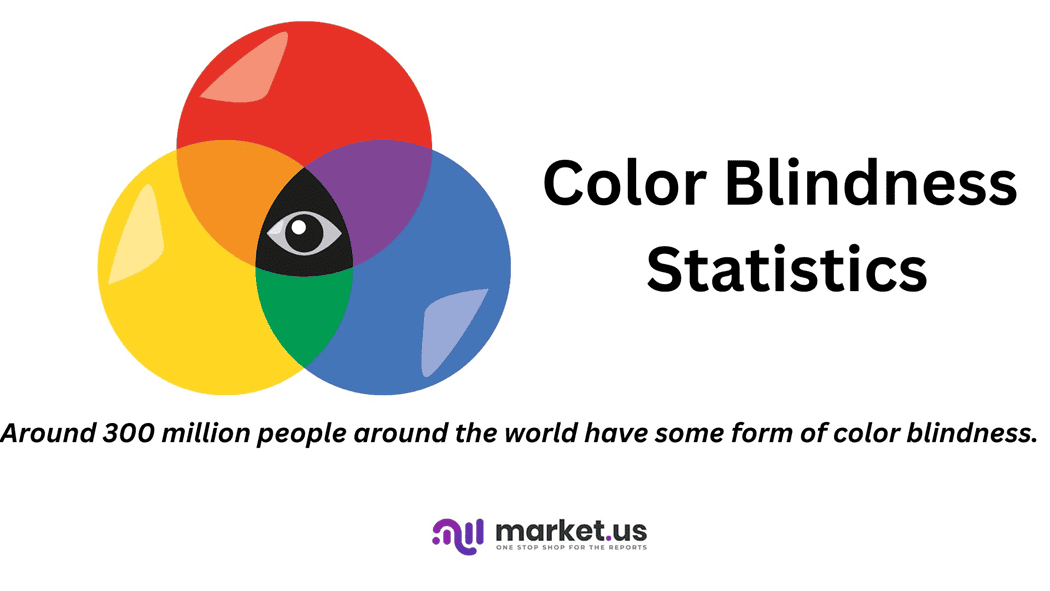
Editor’s Choice
- The Global Vision Care Market size is expected to be worth around USD 113.8 Billion by 2032 from USD 74.9 Billion in 2023.
- Deuteranomaly, commonly referred to as Deutan, is the most frequent type of color blindness. It affects roughly 6% of men and results from a reduced sensitivity to green light, complicating the differentiation between red and green.
- The prevalence of color blindness differs notably across various nations, impacting males and females at different rates. In the Arab population, 10% of males and 0.5% of females are color blind, leading to an overall prevalence of 5.2%.
- India reported the highest total vision loss at 275.0 million individuals in 2020, encompassing 9.2 million with blindness, 79.0 million with moderate to severe vision impairment, 49.1 million with mild vision impairment, and 137.7 million with near vision issues, from a total population of 1,422 million.
- The majority of color blindness cases are red-green, comprising 98% of instances.
- The percentage of subjects reporting difficulties with color-related everyday tasks varies significantly between dichromats and anomalous trichromats. Among dichromats, 86% report difficulties in selecting colors, compared to 66% of anomalous trichromats.
- Approximately 75% of color-blind individuals report needing to ask coworkers to verify colors for them on a weekly or daily basis, with 31.28% doing so almost daily and 43.47% a few times a week.
- EnChroma’s “Color Accessibility Program” partners with over 150 organizations, including museums, libraries, and schools, to offer color-blind individuals access to EnChroma glasses, which enhance color perception.
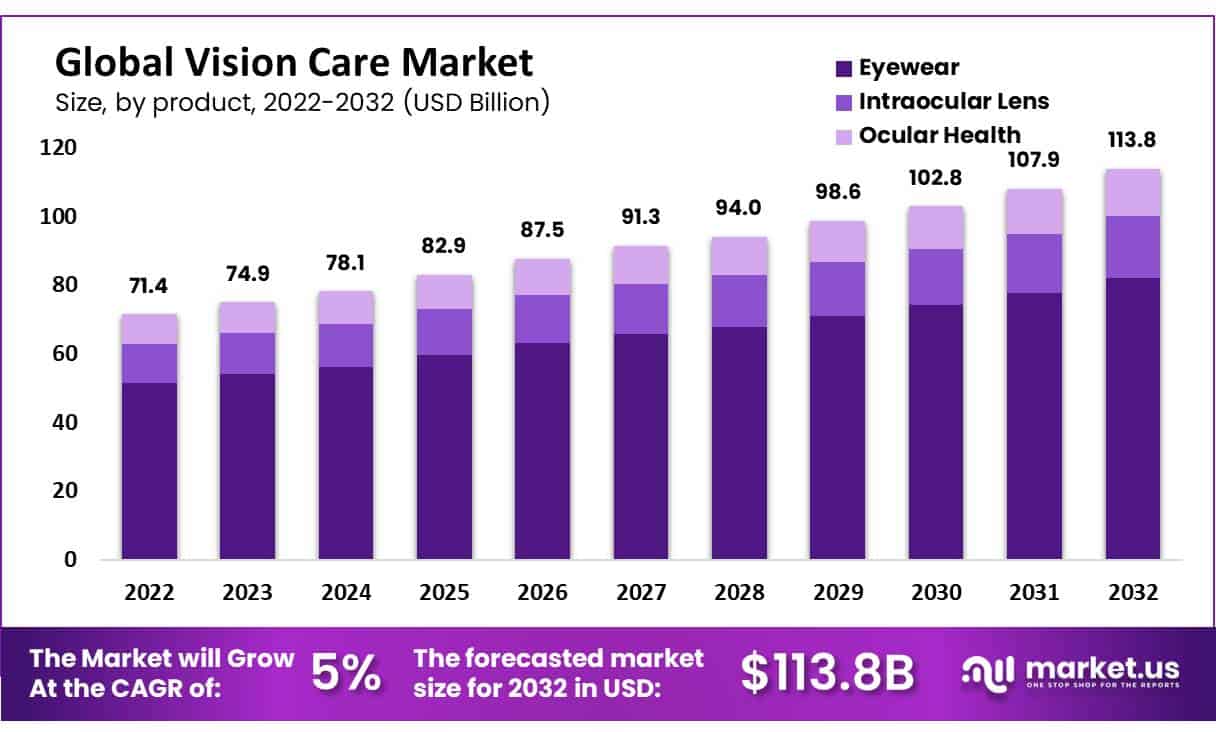
Visual Impairment Statistics
Number of People Worldwide with Vision Impairment
- The data presented highlights the global prevalence of vision impairment for the years 1990 and 2015, measured in millions.
- In 1990, approximately 30.6 million individuals were classified as blind, while 159.9 million experienced moderate to severe vision impairment.
- By 2015, these figures had risen to 36 million for blind people and 216.6 million for those with moderate to severe vision impairment.
- This data underscores a significant increase in vision impairment cases over the 25 years.
(Source: Statista)
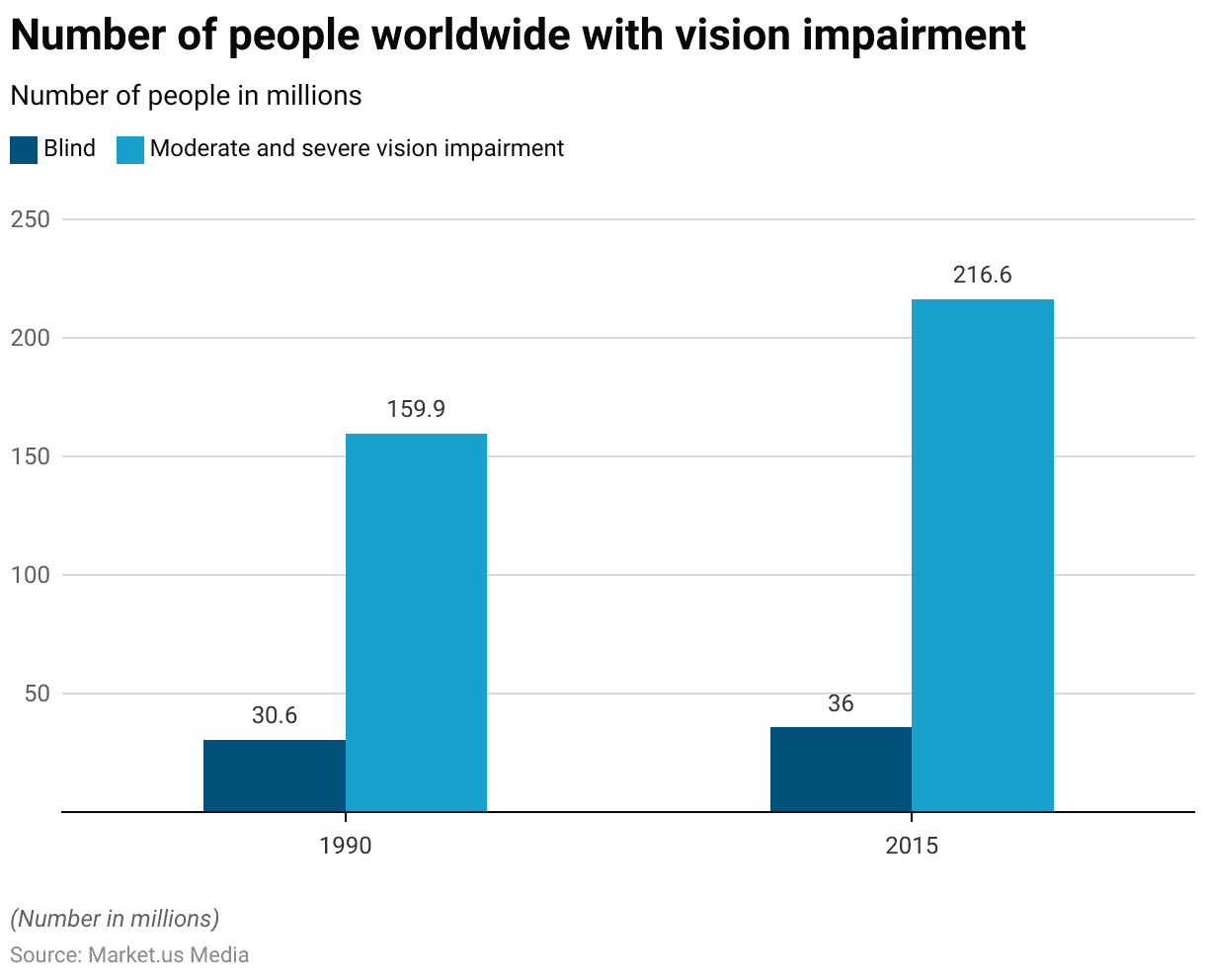
Prevalence of Blindness and Moderate to Severe Visual Impairment – By Region
- The prevalence of blindness and moderate to severe visual impairment in 2015 varied significantly across different regions worldwide.
- South Africa exhibited the highest prevalence rate at 5.70%, closely followed by both Western sub-Saharan Africa and North Africa and the Middle East, each with a 5.60% prevalence rate.
- East and Central sub-Saharan Africa both reported a 4.60% prevalence.
- South-East Asia had a prevalence rate of 4.50%, while Oceania reported 4.00%.
- Andean Latin America’s prevalence was slightly lower at 3.90%, with East Asia at 3.40% and Southern sub-Saharan Africa at 3.30%.
- Central Latin America and the Caribbean each had a prevalence of 2.70%, and Central Asia reported 2.60%.
- Eastern Europe had a prevalence of 2.10%, while both Southern and Tropical Latin America reported a 2.00% prevalence.
- Lower rates were observed in Central Europe at 1.60%, Australasia at 1.50%, North America at 1.40%, and Western Europe at 1.20%.
- These figures illustrate the varying degrees of visual health challenges faced by different regions around the globe.
(Source: Statista)
Take advantage of our unbeatable offer - buy now!


Prevalence of All Vision Loss – According to Country
- The prevalence of vision loss by country in 2020 reflects significant disparities in the global distribution of vision impairments across different categories, including total vision loss, blindness, moderate to severe vision impairment, mild vision impairment, and near vision loss.
- India reported the highest total vision loss at 275.0 million individuals, encompassing 9.2 million with blindness, 79.0 million with moderate to severe vision impairment, 49.1 million with mild vision impairment, and 137.7 million with near vision issues, from a total population of 1,422 million.
- China is closely followed by 274.3 million people experiencing vision loss, including 8.9 million blind individuals, from a population of 1,426 million.
- Other notable figures include Indonesia, with 34.9 million people affected; Russia, with 28.6 million; and Brazil with 26.6 million.
- Each country shows varying degrees of vision impairment across different severity levels. For instance, the USA, with a population of 331 million, reported 16.4 million cases of vision loss, including 0.6 million cases of blindness.
- Mexico showed similar figures, with 16.0 million total vision impairments and 0.5 million blinds out of a population of 132 million.
- These statistics illustrate the extensive impact of vision loss on public health across different global regions.
(Source: IAPB – Vision Loss)
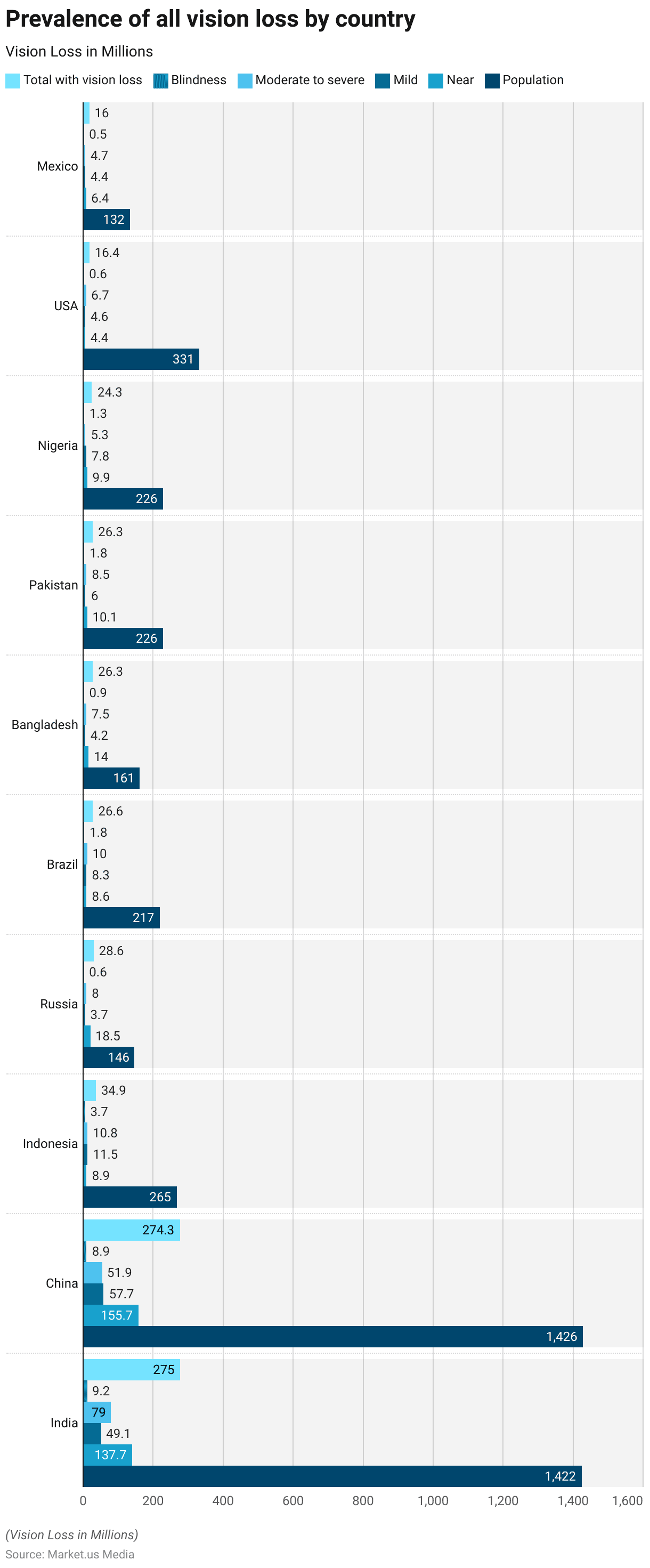
Types of Color Blindness Statistics
- Tritanomaly, also known as blue-yellow color blindness, is a rare disorder impacting males and females equally. It affects the blue color cones, making it difficult to differentiate between blue, green, red, and yellow shades.
- Protanopia is the second most prevalent form of color blindness, characterized by a diminished sensitivity to red light, leading to challenges in distinguishing between red and green colors.
- Deuteranomaly, commonly referred to as Deutan, is the most frequent type of color blindness. It affects roughly 6% of men and results from a reduced sensitivity to green light, complicating the differentiation between red and green.
- Achromatopsia is a condition of complete color blindness, where affected individuals only see in white, black, and various greys.
(Source: Color-Blindness)
Color Blindness Across Different Nations Statistics
Prevalence of Color Blindness in Different Nations’ Statistics
- The prevalence of color blindness differs notably across various nations, impacting males and females at different rates.
- In the Arab population, 10% of males and 0.5% of females are color blind, leading to an overall prevalence of 5.2%.
- Similarly, in India, 8.7% of males and 1.6% of females experience color blindness, resulting in the same total prevalence of 5.2%.
- Russia shows a prevalence of 9.2% among males and 0.5% among females, with a total prevalence of 4.8%.
- In Norway, the figures are slightly lower, with 9% of males and 0.5% of females affected, culminating in a total prevalence of 4.7%.
- France reports color blindness in 8.6% of males and 0.5% of females, totaling 4.5%.
- Germany sees 7.7% of its male population and 0.5% of its female population affected, with an overall prevalence of 4.1%.
- In China, 6.9% of males and 0.5% of females are color blind, leading to a total prevalence of 3.7%. Lastly, in Japan, the condition affects 5% of males and 0.2% of females, with a total prevalence of 2.6%.
- These statistics underline the varying genetic predisposition to color blindness in different global populations.
(Source: Colorblind Guide)
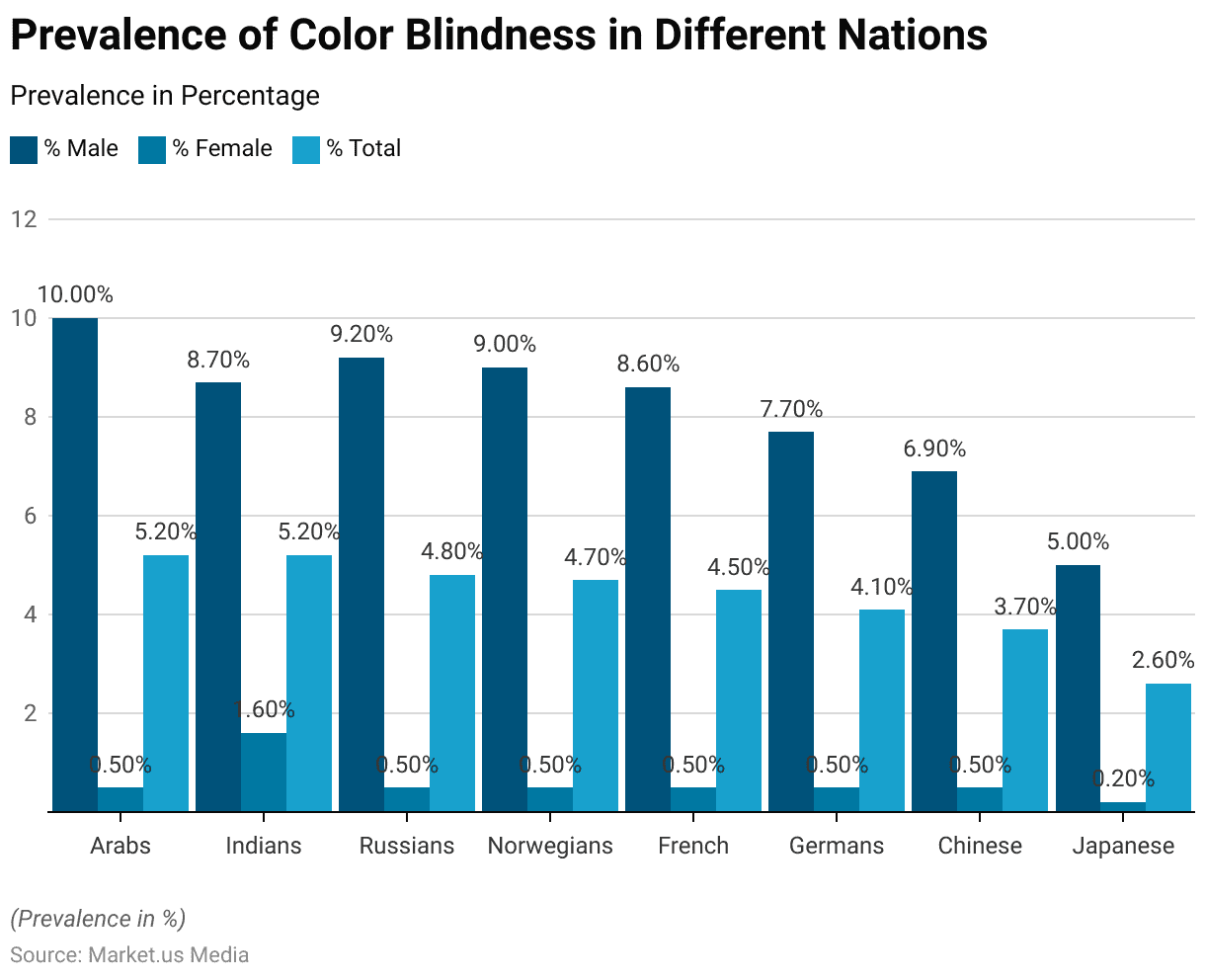
Prevalence of Red-Green Colorblindness – By Country
- China has the highest number of people affected by red-green colorblindness, with an estimated 107 million residents experiencing this condition.
- India follows with 74 million individuals, while the USA ranks third with 32 million affected.
- Indonesia reports 29 million people with red-green colorblindness, closely followed by Pakistan with 28 million.
- Brazil has a reported 25 million people living with this condition, Nigeria has 20 million, Bangladesh 19 million, Russia 14 million, and Mexico round out the list with 12 million individuals affected.
- This data highlights the significant prevalence of red-green colorblindness across these diverse nations.
(Source: covisn.com)
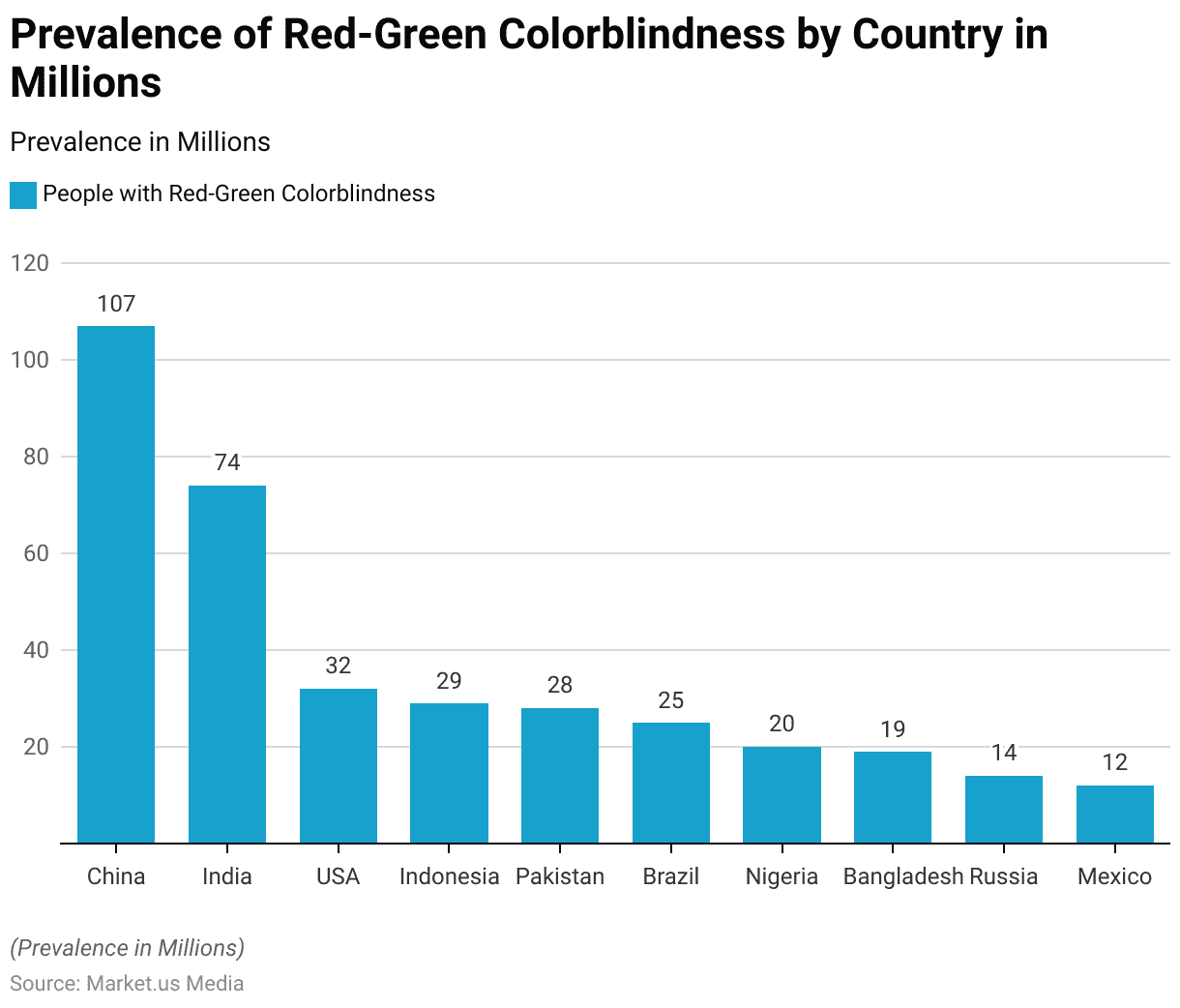
Demographic Insights
By Age
- The prevalence of color vision defects (CVD) in the Indian population, as assessed at a pre-employment screening center of a tertiary care hospital, varies across different age groups and between genders.
- In males under 20 years old, the prevalence is 2.44%, and no females in this age group were found to have CVD.
- For the age group 20-29, the prevalence is higher in males at 3.96%, while it is 0.19% in females.
- Males aged 30-39 and 40-49 show a prevalence of 3.49% and 3.27%, respectively, with no cases recorded among females in these age brackets.
- The highest prevalence is observed in the 50-59 age group, with males at 5.81% and females at 2.86%. Individuals older than 59 showed no prevalence of CVD in either gender.
(Source: International Journal of Contemporary Medical Research)
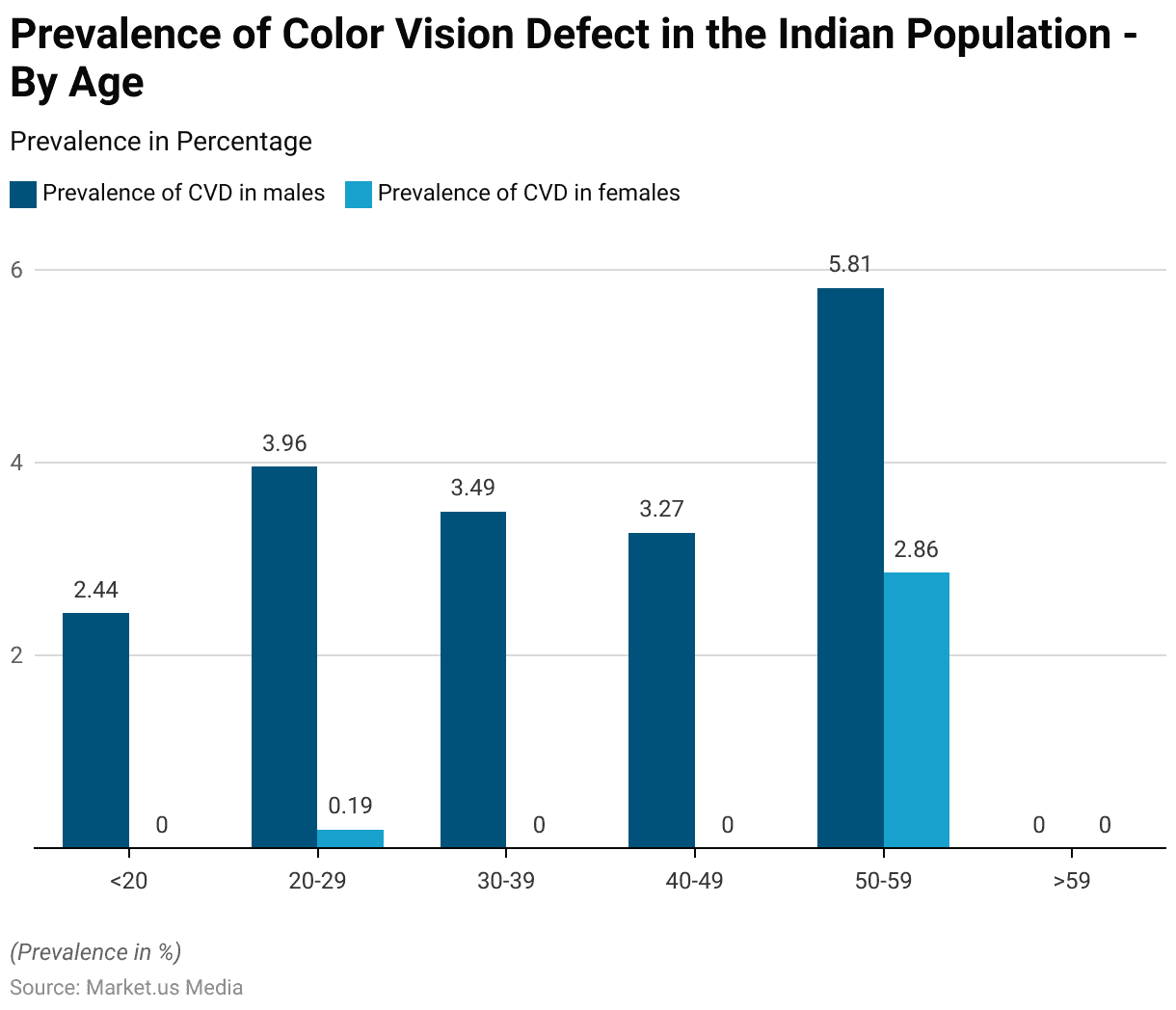
By Gender
Among Children
- In a study on red-green color blindness among Singaporean children, two categories of color vision issues were identified: “Color-blind” and “Intermediate.”
- For those classified as color-blind, the total prevalence was recorded at 2.6%, with a significantly higher prevalence among males at 5.2% compared to females at just 0.2%.
- The “Intermediate” category, which represents a less severe form of color vision deficiency, showed a total prevalence of 0.5%.
- Interestingly, in this category, the prevalence was higher among females at 0.6% compared to males at 0.3%.
- These statistics highlight the gender disparities in the prevalence of color vision deficiencies among children in Singapore.
(Source: Research Gate)
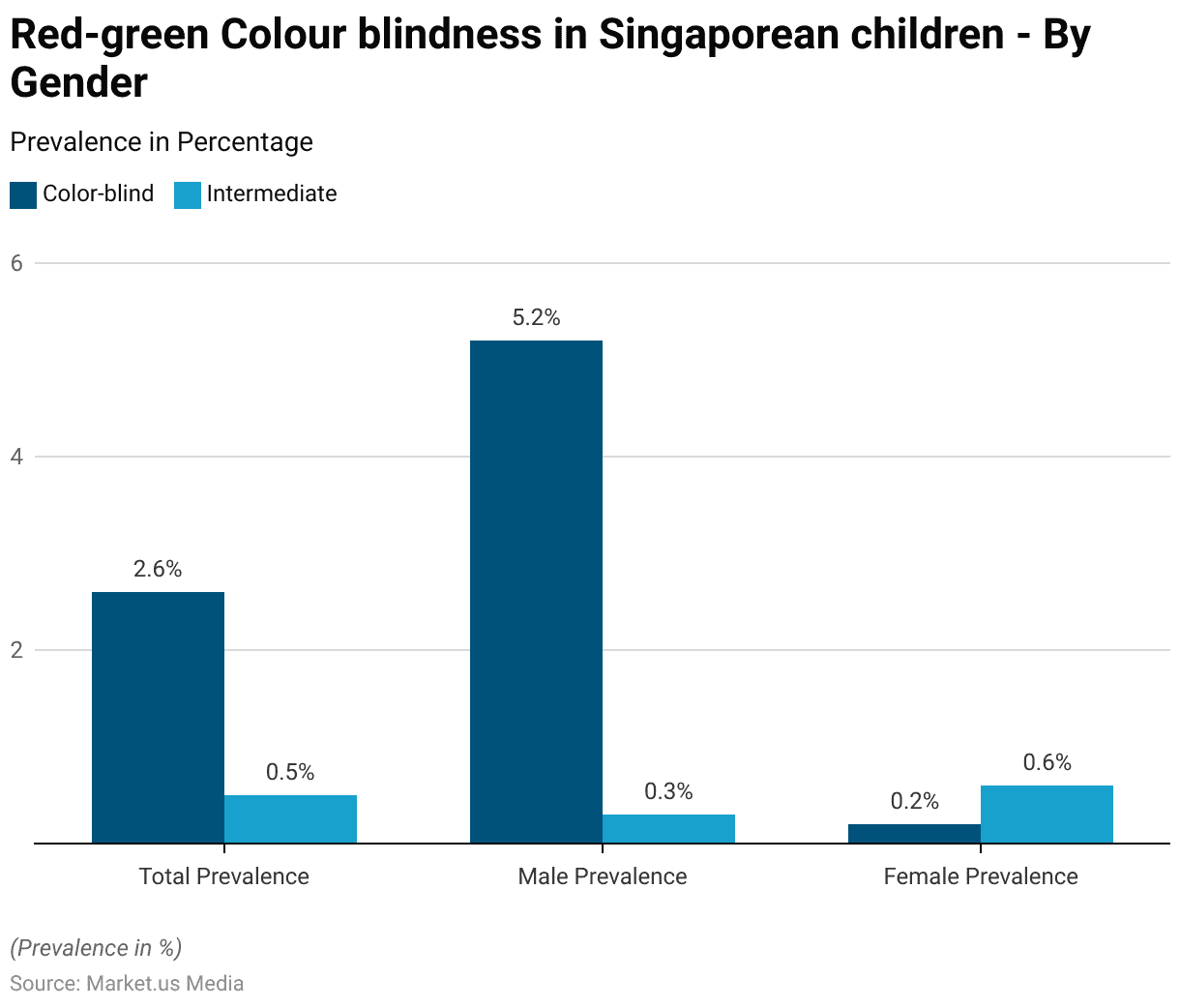
Among Adults
- The prevalence of color vision deficiency among adults shows distinct differences based on gender.
- In men, 91.40% have normal vision, but there are noticeable rates of cone defects: 2.45% have an L-cone defect, 6.10% have an M-cone defect, and a very small fraction, 0.011%, have an S-cone defect.
- In contrast, women exhibit higher normal vision rates at 99.60%, with much lower incidences of cone defects: L-cone defects are seen in only 0.04%, M-cone defects in 0.36%, and S-cone defects in 0.04%.
- Overall, for the entire adult population, 95.50% have normal vision, 1.25% have L-cone defects, 3.24% have M-cone defects, and 0.025% have S-cone defects.
- This data underscores significant gender disparities in the distribution of color vision deficiencies.
(Source: Iris)
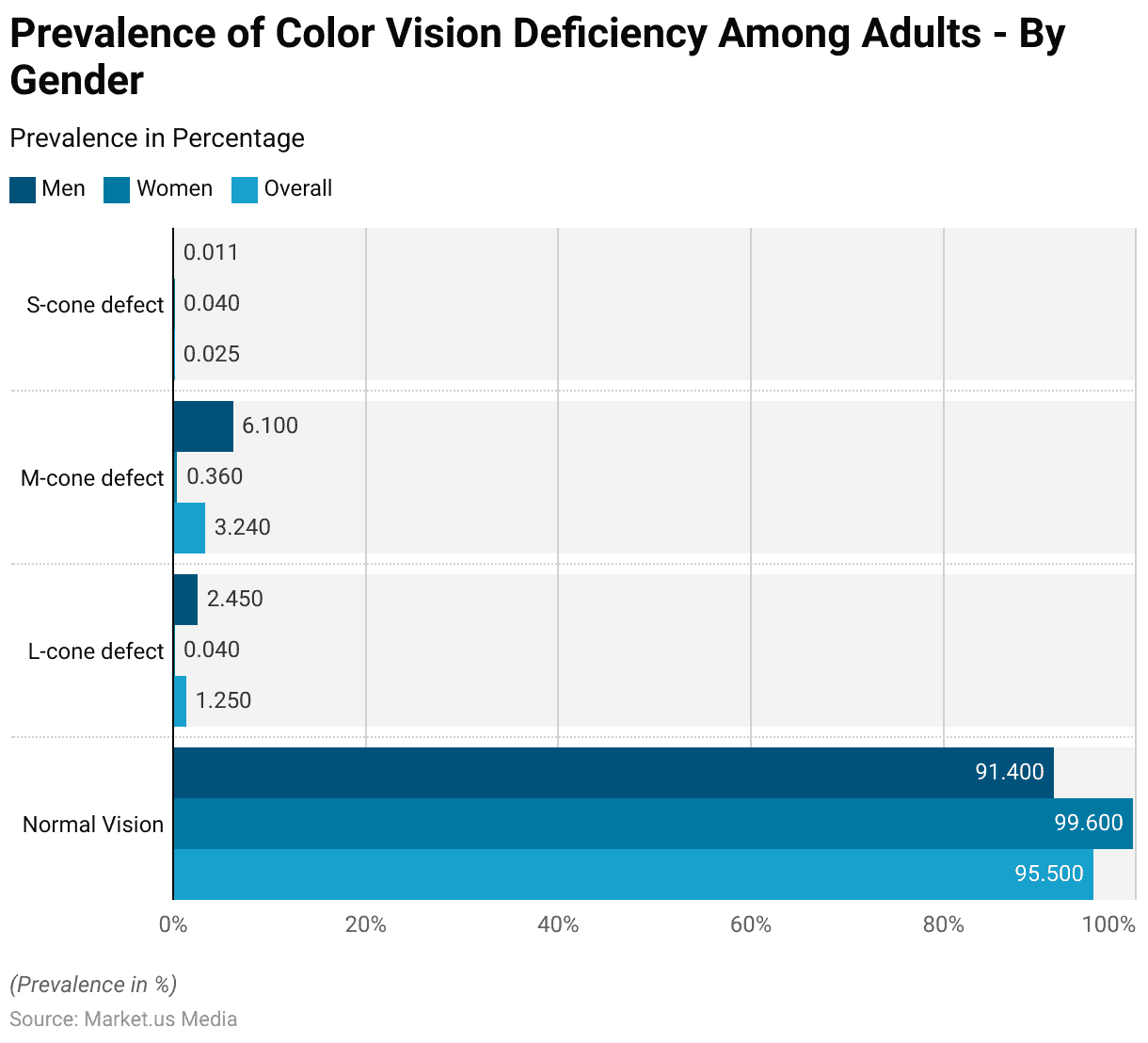
By Ethnicity
- The prevalence of color vision deficiency in boys varies significantly across different ethnic groups. Caucasian boys exhibit the highest prevalence rate at 5.60%.
- Asian boys follow this with a prevalence rate of 3.10%.
- Hispanic boys show a lower prevalence of 2.60%, and Black boys have the lowest reported prevalence at only 1.40%.
- These statistics highlight the variations in genetic predisposition to color vision deficiencies among different ethnicities.
(Source: Iris)
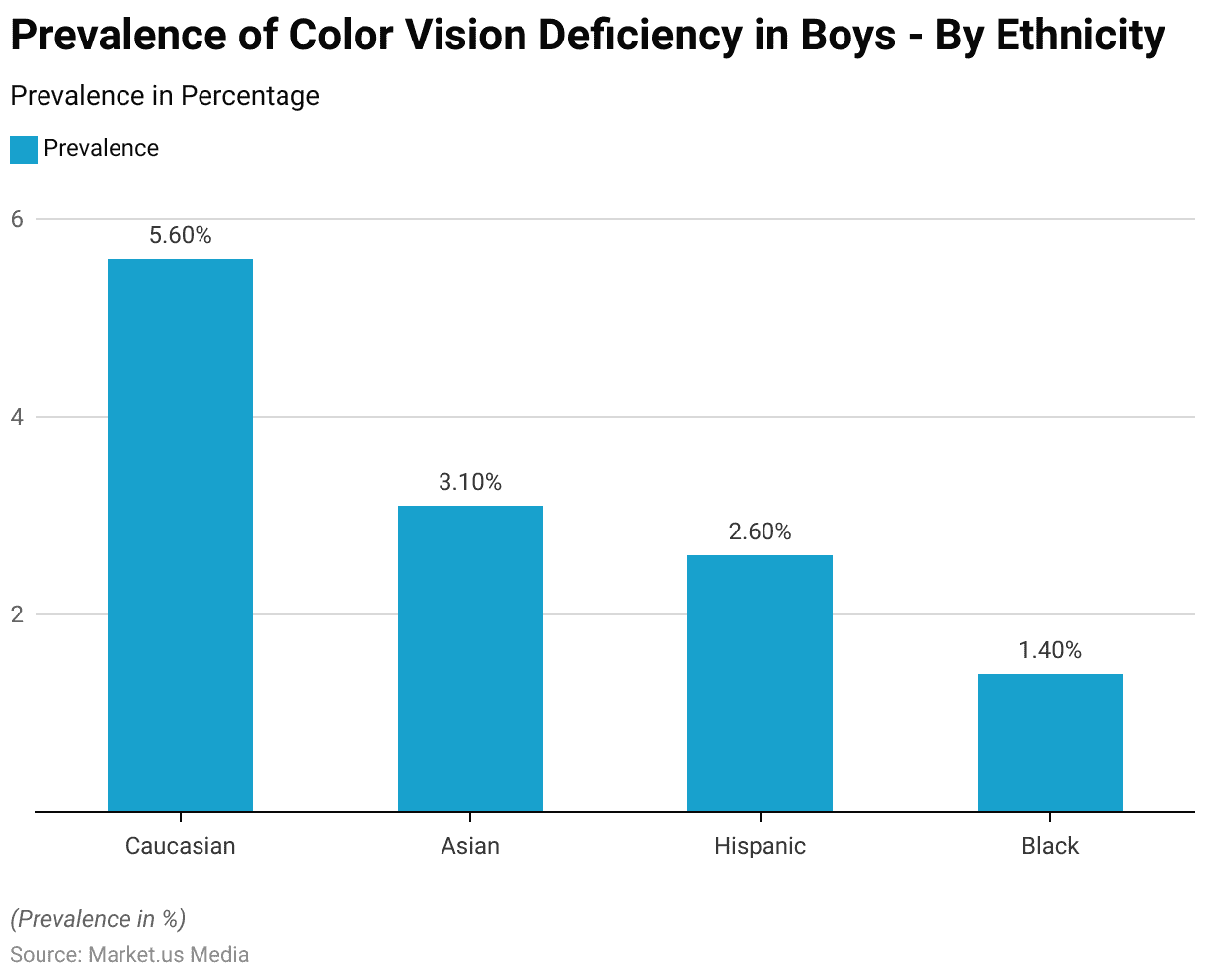
Variations in Color Blindness Prevalence – By Color Type Statistics
Color Blindness Prevalence – By Color Type Statistics
- The majority of color blindness cases are red-green, comprising 98% of instances.
- About 25% of these cases are believed to be the protein type of red-green color blindness.
- Blue-yellow color blindness, which is significantly rarer, affects approximately 1 in 10,000 people.
- Blue cone monochromacy is even less common, affecting about 1 in 100,000 individuals.
- Additionally, achromatopsia occurs in about 1 in 30,000 people.
- Unlike other forms, blue-yellow color deficiency does not show a gender preference, affecting men and women equally.
(Source: Cleveland Clinic)
Frequencies of Different Types of Color Blindness Statistics
- The prevalence of different types of color blindness varies within the general population, reflecting distinct genetic variations affecting cone cells in the eye.
- Deuteranomaly, where there is a malfunctioning green cone, is the most common type, affecting 2.32% of the population.
- Protanomaly, involving a malfunctioning red cone, affects 0.54%, while Tritanomaly, with a malfunctioning blue cone, is quite rare at only 0.02%.
- For those missing cone cells entirely, Deuteranopia (missing green cone) is present in 0.64% of the population, Protanopia (missing red cone) in 0.51%, and Tritanopia (missing blue cone) is the least common, affecting just 0.01%.
- These statistics provide insight into the distribution and impact of various color vision deficiencies.
(Source: Extensis)

Difficulties Faced Due to Color Blindness Statistics
- The percentage of subjects reporting difficulties with color-related everyday tasks varies significantly between dichromats and anomalous trichromats.
- Among dichromats, 86% report difficulties in selecting colors, compared to 66% of anomalous trichromats.
- The impact on hobbies is also notable, with 68% of dichromats and 23% of anomalous trichromats reporting interference.
- When it comes to identifying flowers, 57% of dichromats face challenges versus 18% of anomalous trichromats.
- Picking ripe fruit is problematic for 41% of dichromats and 22% of anomalous trichromats.
- Determining if meat is fully cooked is difficult for 35% of dichromats and 17% of anomalous trichromats.
- Additionally, 32% of dichromats and 18% of anomalous trichromats find that their color vision deficiency affects their participation in sports or games.
- Lastly, identifying skin conditions like sunburn is challenging for 27% of dichromats and 11% of anomalous trichromats.
- These statistics highlight the varying degrees of difficulty experienced by individuals with different types of color vision deficiencies in handling daily tasks that require color discernment.
(Source: Color Blind Research)
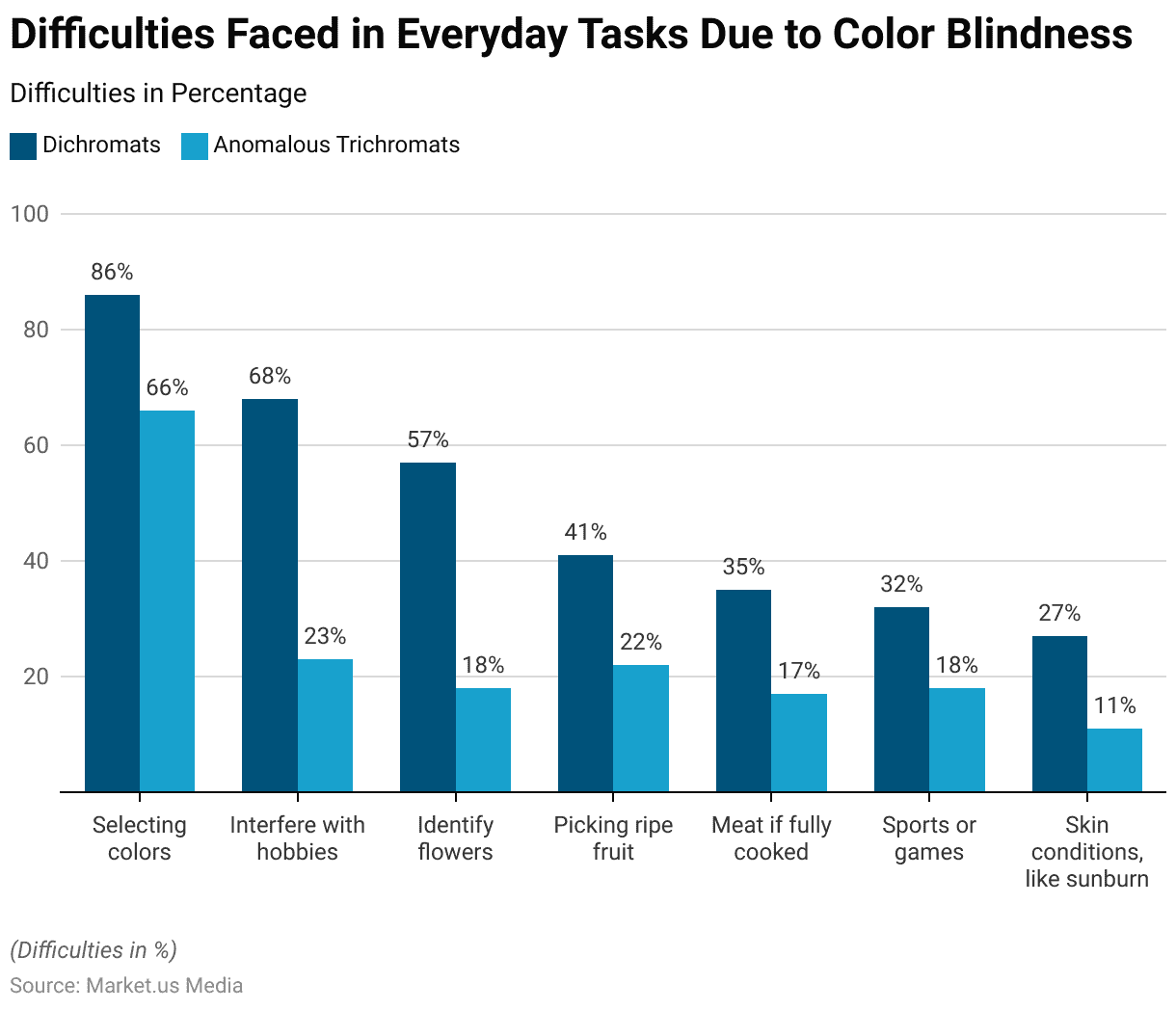
Global Prevalence and Gender Distribution of Color Vision Deficiencies (CVDs) in Educational Institutions
- Studies on the prevalence of color vision deficiencies (CVDs) reveal significant variations across different regions and populations.
- In Egypt, at Assiut University, the prevalence among students was 6.9%, with male students exhibiting higher rates (7.7% for red-green color blindness and 5.5% for total color blindness) compared to female students (1.9% and 0.7%, respectively).
- Similar prevalence rates were observed in another Egyptian study at Menofia University (8.75%) and a Turkish survey (7.33%). An Iraqi study in Erbil City reported a prevalence of 6.25%, with higher rates among male students.
- In Northern India, prevalence among children ranged from 5.26% to 11.36%, and in Manipur, India, the rate was 5.28%. A study from Iran showed a notably higher prevalence at 13.93%, with males at 15.85% and females at 12.96%.
- In contrast, lower rates were reported in other studies, such as 21.3% among male school students in Jizan City, Saudi Arabia, and only 2.2% among school children in Durban, South Africa. A Jordanian university study found a red-green color blindness prevalence of 1.6%, with a striking gender disparity (8.72% in men and 0.33% in women).
- The medical faculties in Nepal and Cameroon reported prevalences of 5.6% and 1.6%, respectively, suggesting a potential influence of strict health prerequisites for certain educational programs on the lower prevalence.
- Moreover, a Saudi study highlighted the significance of a positive family history and the genetic basis of CVDs, with no significant association found between refractive errors and CVDs.
- These varied findings underscore the complex interplay of genetic, demographic, and environmental factors influencing the prevalence of color vision deficiencies globally.
(Source: World Health Organization)
Impact of Color Blindness on Workplace Efficiency Statistics
- Approximately 75% of color-blind individuals report needing to ask coworkers to verify colors for them on a weekly or daily basis, with 31.28% doing so almost daily and 43.47% a few times a week.
- This necessity stems from tasks involving distinguishing colors on wires, medicine labels, chemicals, graphs, drawings, or other items.
- Moreover, more than three-quarters (77.44%) of color-blind workers experience frustration or delays at work due to their condition, with 35.59% facing challenges almost every day and 41.85% occasionally (about once per week).
- Over half (51.51%) worry that their color blindness could lead them to make mistakes at work.
- Despite these challenges, a significant majority (80.18%) believe that EnChroma glasses, which are designed to enhance color perception for color-blind individuals, could help them perform their jobs better.
- Additionally, 63% feel that these glasses might save them time, improve productivity, and boost their confidence in the workplace.
(Source: EnChroma Survey)
Prevalence of Color Blindness Among Drivers Statistics
By Age
- In a cross-sectional study focusing on color vision deficiencies (CVD) among male professional drivers in Karachi, the prevalence and frequency of CVD across different age groups were analyzed.
- Drivers between the ages of 20-30, making up 23% of the participants, showed no cases of CVD.
- Those aged 31-40, who constituted 37% of the study population, exhibited a higher frequency, with 5 cases of CVD recorded.
- Similarly, the age group of 41-50, representing 31% of the participants, also displayed CVD cases, numbering 4 in total.
- However, in the oldest cohort of drivers, aged 51-60, which comprised 9% of the participants, no CVD cases were found.
- This distribution underscores a notable presence of color vision deficiencies among middle-aged drivers while highlighting its absence in the youngest and oldest age groups surveyed.
(Source: World Health Organization)
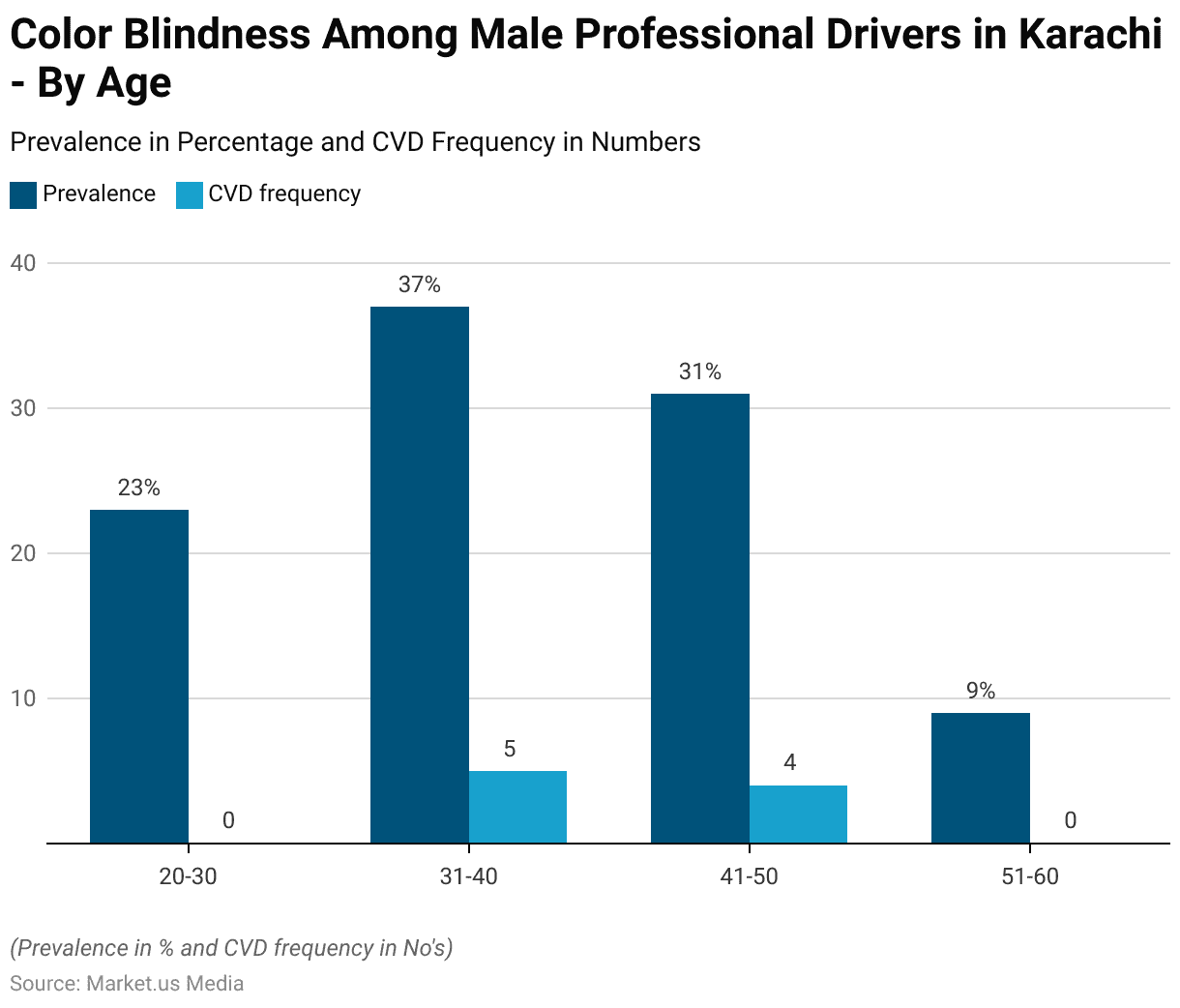
By Education
- The cross-sectional study conducted among male professional drivers in Karachi also explored the relationship between education levels and the prevalence of color vision deficiencies (CVD).
- The findings indicated that drivers without any education, representing 21% of the participants, had no reported cases of CVD.
- Those with primary education up to 5 years, constituting 28% of the sample, had a CVD frequency of 1 case.
- Drivers with secondary education up to 10 years, who formed the largest group at 36%, exhibited 6 cases of CVD, indicating a higher frequency in this group.
- Lastly, those with higher education above ten years, making up 15% of the participants, reported 2 cases of CVD.
- This data suggests varying frequencies of color vision deficiencies correlating with different educational backgrounds among the drivers studied.
(Source: World Health Organization)

According to Years of Driving
- In the cross-sectional study of male professional drivers in Karachi, the prevalence of color vision deficiencies (CVD) was assessed according to years of driving experience.
- Among drivers with 1 to 5 years of driving experience, which accounted for 13% of the population, there were 3 cases of CVD.
- Those with 6 to 10 years of driving experience represented 19% of the sample and reported 5 cases of CVD.
- Interestingly, drivers with 11 to 20 years of experience, making up the largest segment at 40% of the population, had no reported cases of CVD.
- Lastly, drivers with over 20 years of driving experience, constituting 28% of the sample, had just 1 case of CVD.
- This distribution suggests that the occurrence of color vision deficiencies among professional drivers does not necessarily correlate with longer periods of driving experience.
(Source: World Health Organization)
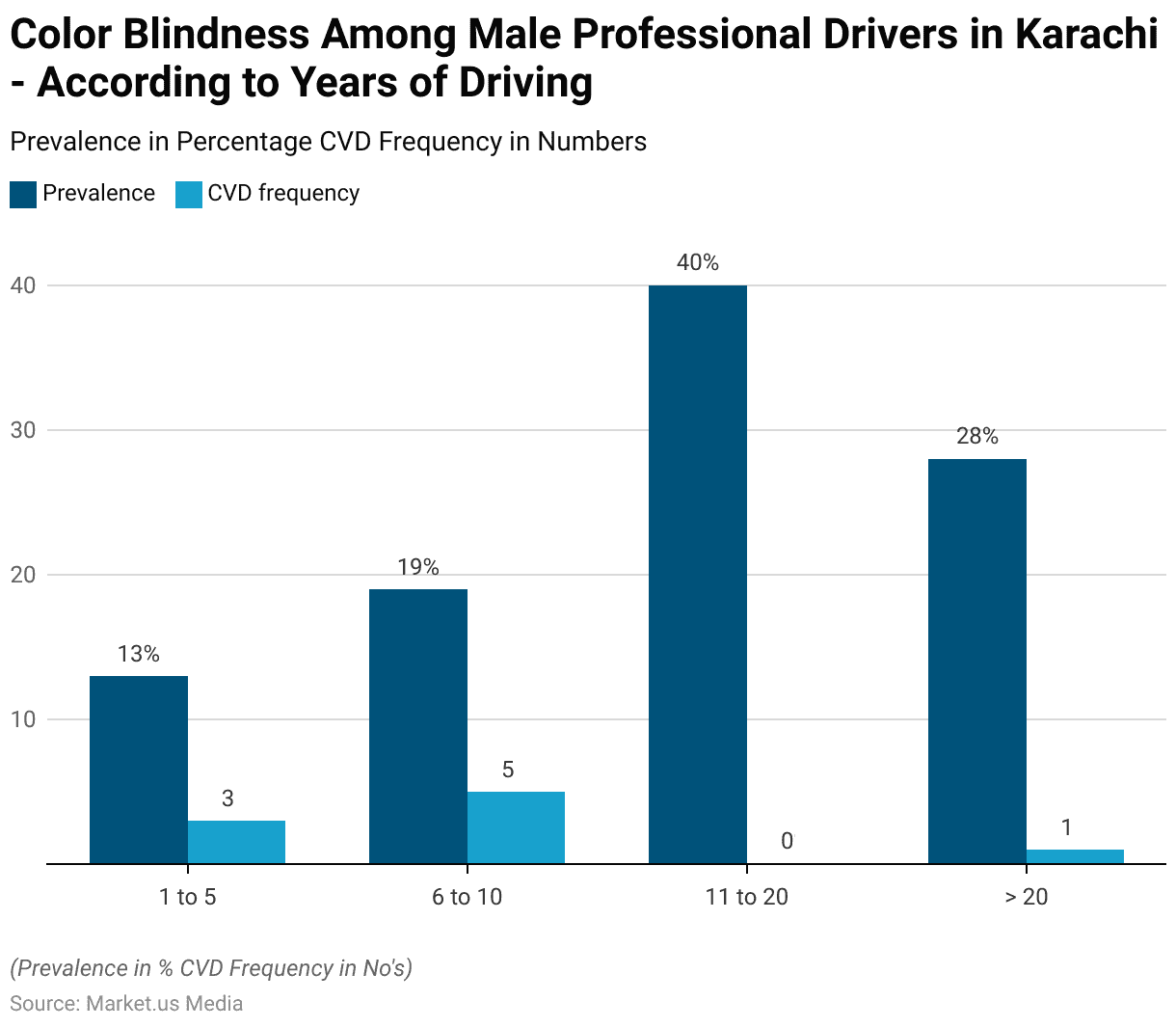
Remedies and Treatments
Global Vision Care Market Size
- The global vision care market has demonstrated consistent growth from 2016 to 2022.
- In 2016, the market value was approximately $54 billion.
- It increased gradually each year, reaching $55.8 billion in 2017, followed by $57.7 billion in 2018, and $59.7 billion in 2019.
- Despite global economic fluctuations, the market continued to expand to $61.7 billion in 2020 and further to $63.8 billion in 2021.
- By 2022, the market value had grown to an estimated $66 billion, reflecting a steady increase in the demand and expansion of the vision care sector over these years.
(Source: Statista)
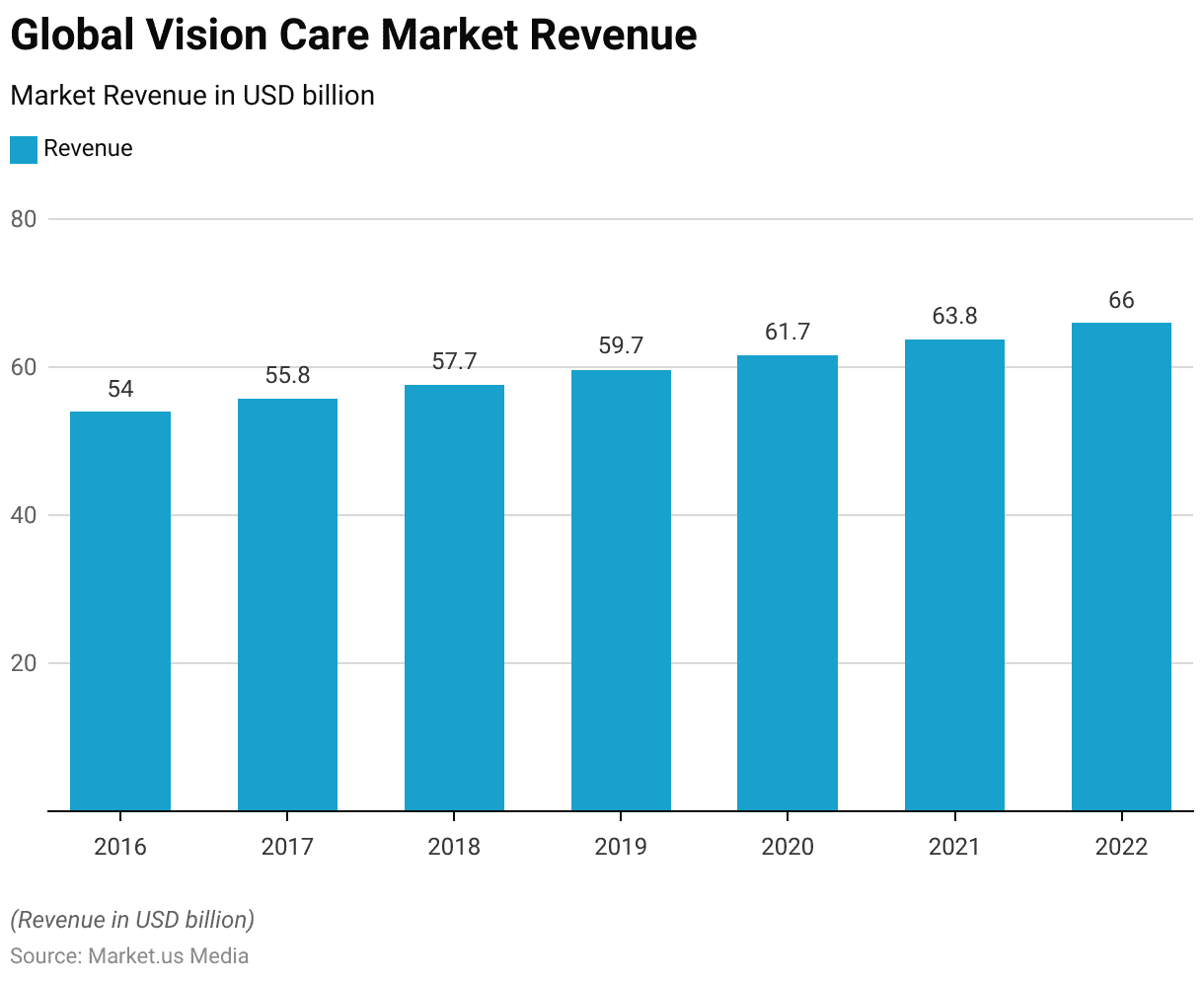
Employees Access to Vision Care Benefits
- In 2023, the distribution of vision care benefits among U.S. employees varied significantly by the type of employment.
- State government workers had the highest access rate at 42%, indicating a relatively robust benefits package in this sector.
- Local government workers also had considerable access, with 37% receiving vision care benefits.
- Access rates were somewhat lower for civil workers, at 29%, and even less for those in private industry, where only 27% of employees had access to vision care benefits.
- This disparity highlights differences in benefit offerings across various employment sectors in the U.S.
(Source: Statista)
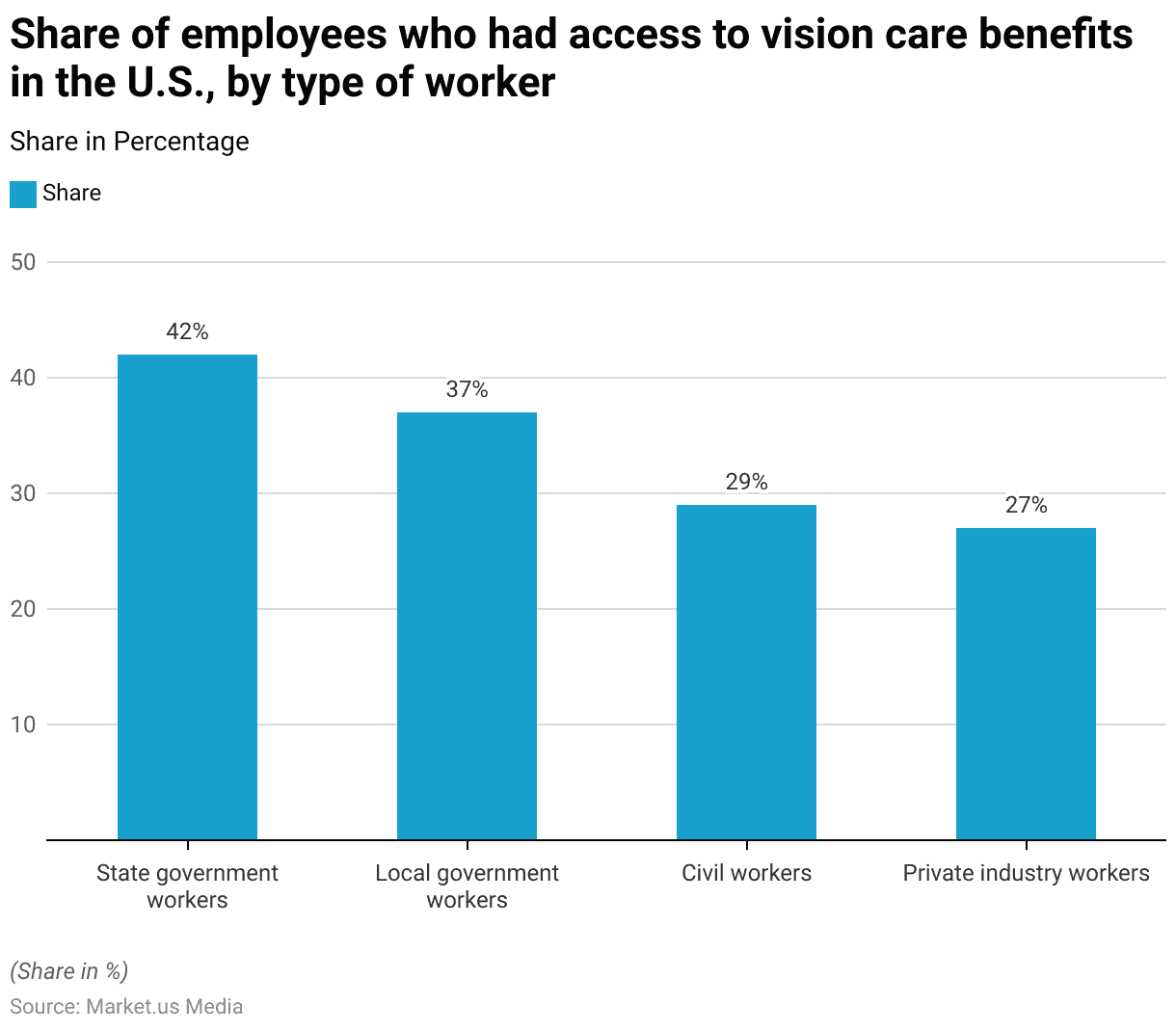
Expenditure on Vision Care
- Between 2017 and 2021, the average annual expenditure on vision care insurance per consumer unit in the United States showed a notable trend of increase, followed by a slight decrease in the final year.
- In 2017, the average spending was $23.13, which increased to $25.46 in 2018.
- The upward trend continued into 2019, with the expenditure rising to $30.74.
- It peaked in 2020 at $31.71, marking the highest spending over the five years.
- However, in 2021, there was a modest reduction in the average expenditure, which decreased to $29.99.
- This pattern reflects changes in consumer spending behavior and possibly fluctuations in market conditions related to vision care insurance over these years.
(Source: Statista)
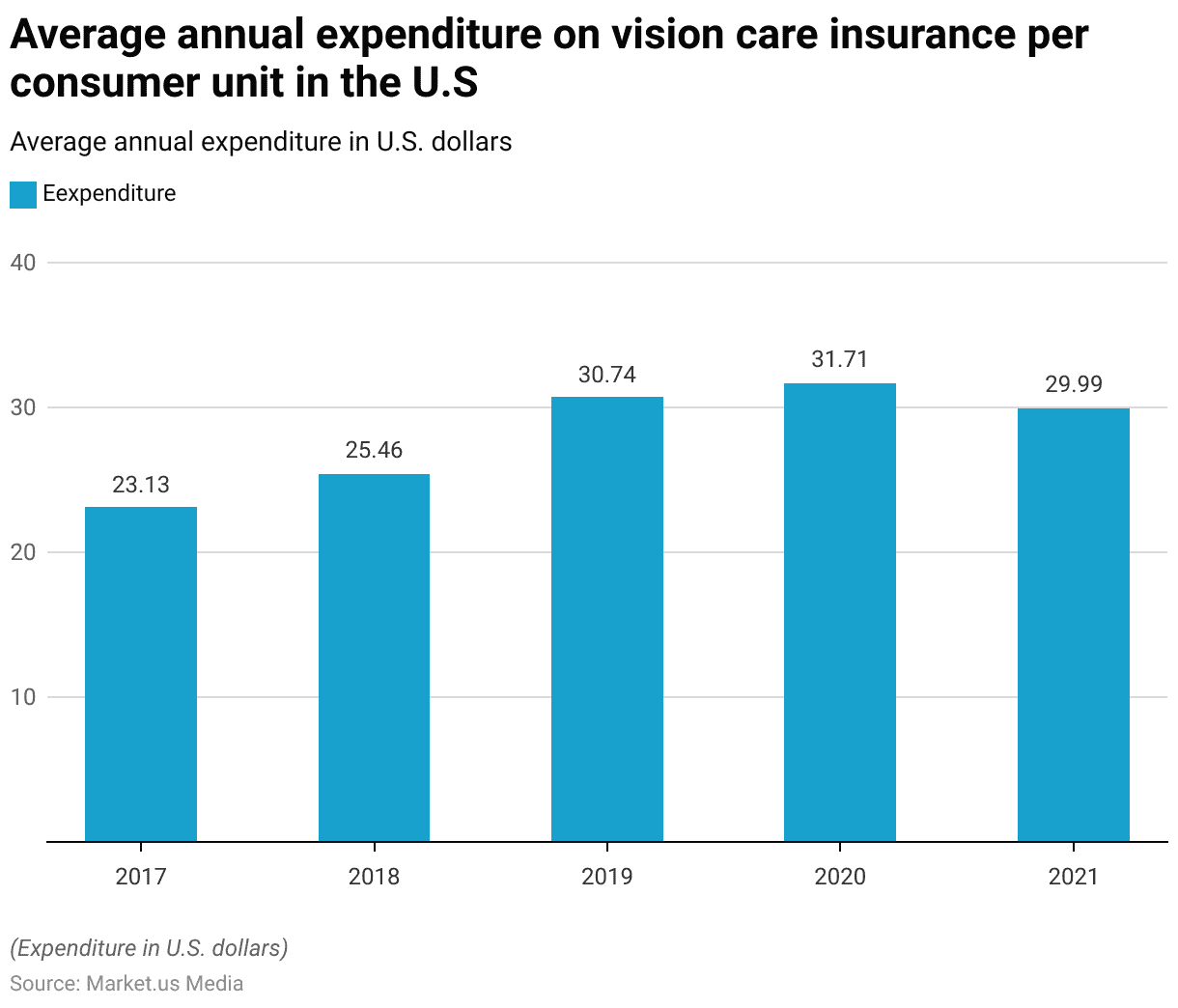
Expenditure on Glasses and Other Vision Products
- From 2011 to 2021, Norway experienced a consistent increase in expenditures on glasses and other vision products.
- Starting in 2011, the expenditure was NOK 5,378 million and saw a gradual rise over the years.
- In 2012, the spending increased slightly to NOK 5,679 million, followed by a marginal rise to NOK 5,702 million in 2013.
- The upward trend continued, with expenditures reaching NOK 5,924 million in 2014 and NOK 6,152 million in 2015.
- By 2016, the expenditure further grew to NOK 6,375 million, and it maintained its ascent each subsequent year, reaching NOK 6,664 million in 2017, NOK 6,887 million in 2018, and NOK 7,211 million in 2019.
- The growth peaked in the following years, with expenditures climbing to NOK 7,790 million in 2020 and further to NOK 8,405 million in 2021, indicating a robust demand for vision care products in Norway over the decade.
(Source: Statista)
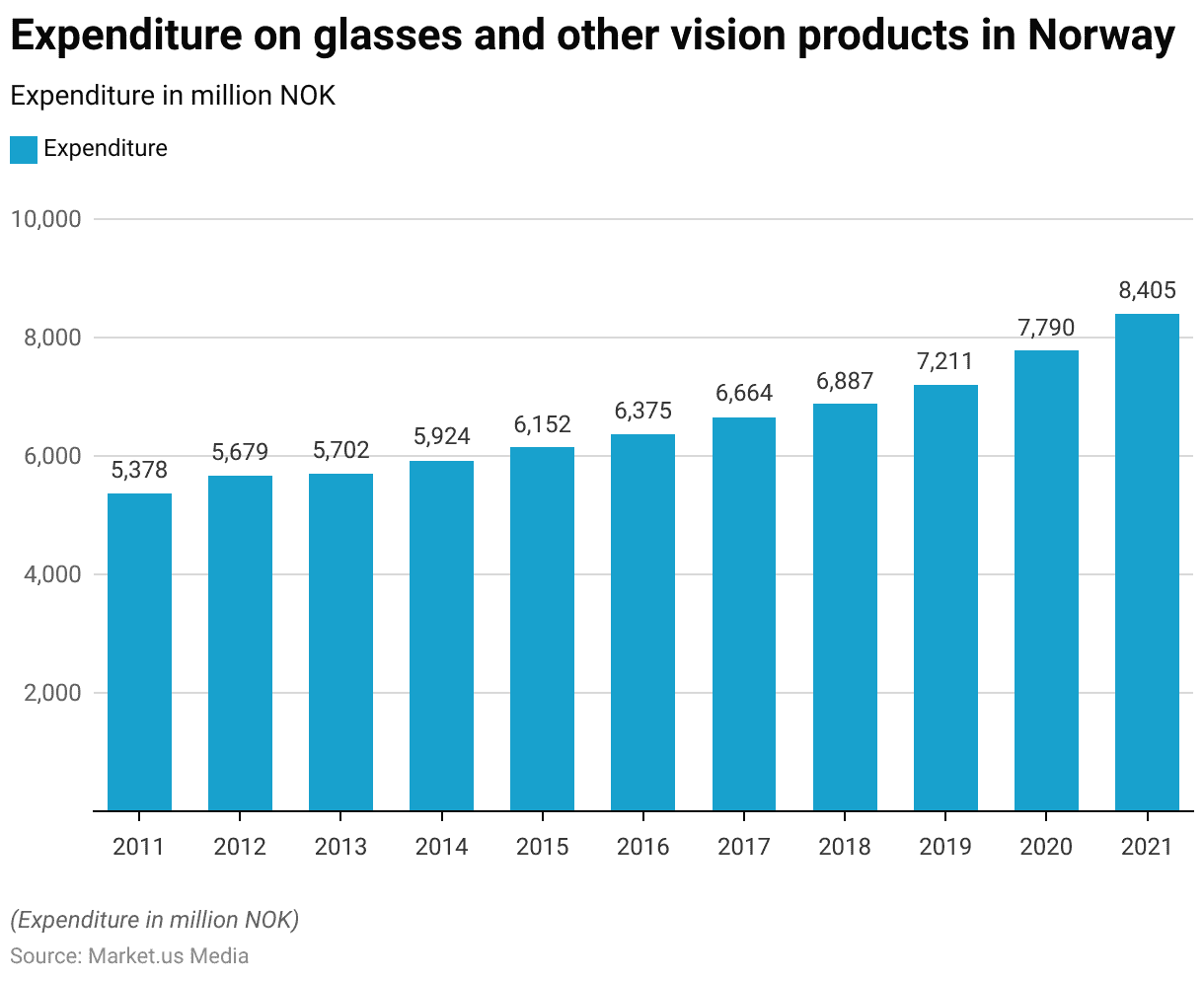
Impact of COVID-19
- In 2020, the impact of the COVID-19 lockdown on access to care services for individuals with eye conditions in the United Kingdom varied across different types of eye conditions and levels of visual impairment.
- For those with moderate or severe sight loss and registered as blind, 1.60% reported an improvement in access to care services, 3.30% experienced a somewhat better situation, 34.10% saw no change, 36.60% felt it became somewhat worse, and 24.40% reported a significant deterioration.
- Individuals with normal vision or mild sight loss experienced better stability, with 1.50% reporting major improvements, 45.60% somewhat better, 41.20% no change, and only 11.80% feeling their access worsened.
- Specific eye conditions showed varying impacts: 1.90% of those with glaucoma felt an improvement, while 23.10% saw a lot worse conditions.
- Those with AMD reported 3.20%, a lot better, and 15.90%, a lot worse. For cataract patients, 1.80% experienced major improvements, but 28.10% reported significant declines. For other eye conditions, 3.40% reported a lot better access, but 24.10% felt it was a lot worse.
- These figures illustrate the diverse effects of the lockdown on people with different eye conditions in the U.K., indicating a generally worsened access to care services during the pandemic period.
(Source: Statista)
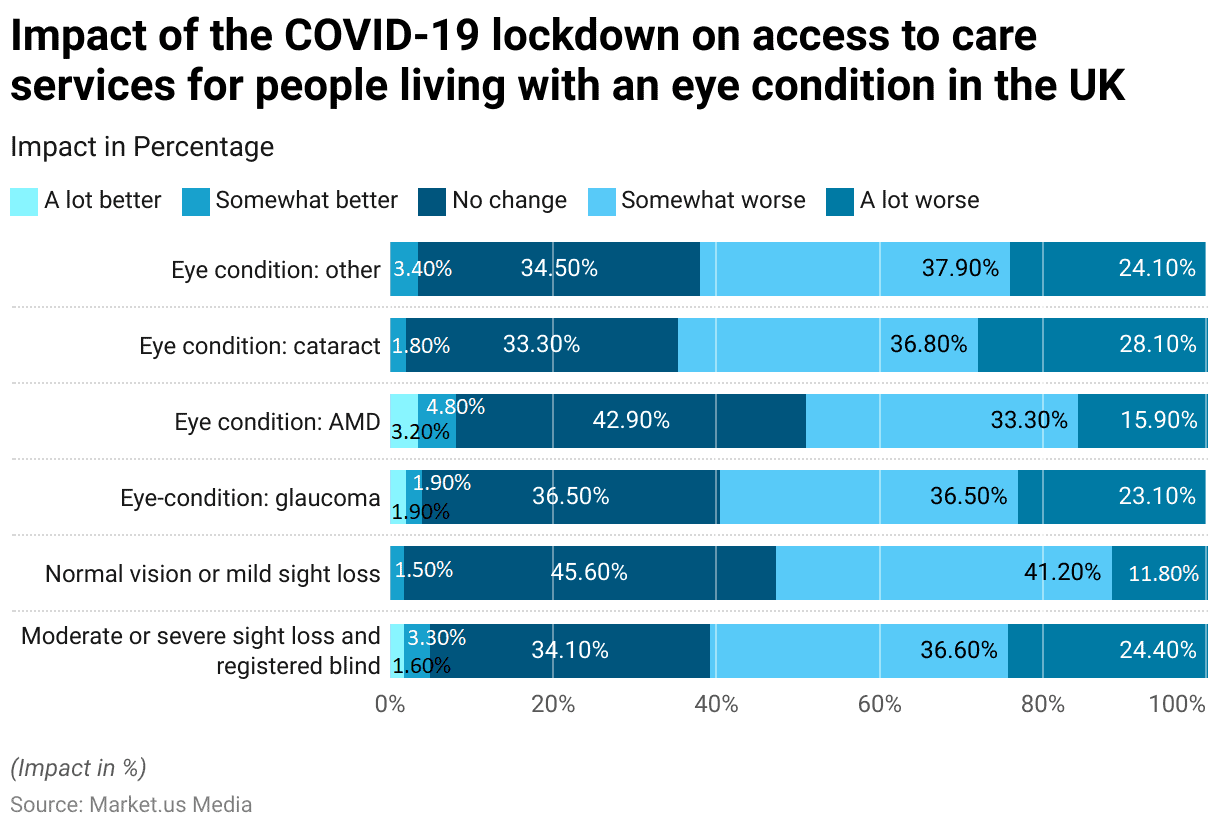
Initiatives and Programs to Cure Color Blindness Statistics
- Several initiatives and programs are addressing the challenges of color blindness, focusing on both technological advancements and awareness campaigns.
- For instance, EnChroma’s “Color Accessibility Program” partners with over 150 organizations, including museums, libraries, and schools, to offer color-blind individuals access to EnChroma glasses, which enhance color perception.
- This program promotes “color accessibility” in public spaces and raises awareness through International Color Blindness Awareness Month.
- Additionally, ongoing research explores gene therapy as a potential long-term treatment, with advancements suggesting that a single injection could correct color vision in the future.
- Organizations like Colormax offer color-corrective lenses, and various apps and tools help color-blind individuals navigate daily life more easily, improving their quality of life. At the same time, larger, permanent solutions are being researched.
- These efforts illustrate a growing commitment to finding both short-term aids and long-term cures for color blindness worldwide.
(Sources: EnChroma, Color Vision Correction, American Academy of Ophthalmology)
Innovations and Developments in Color Blindness Treatment Statistics
- Innovations in color blindness treatment have progressed significantly, driven by advancements in gene therapy, specialized lenses, and digital tools.
- Gene therapy, currently in experimental stages, shows promising results in correcting genetic mutations responsible for color vision deficiencies, especially in cases of complete color blindness.
- Trials, such as those targeting the CNGA3 gene, have demonstrated safety and potential efficacy, paving the way for further research, particularly in younger patients, where the brain’s visual plasticity remains high.
- Additionally, corrective lenses, including glasses and contact lenses, have been developed to enhance color perception by filtering specific wavelengths, improving the daily lives of users.
- Companies and institutions like Ludwig-Maximilians-Universität München and various biotech firms are at the forefront of these developments, focusing on R&D to refine these treatments for broader use.
(Sources: Frontiers, New Atlas, MedTourism)
Government Initiatives for Color Blindness Treatment Statistics
- Governments worldwide are increasingly recognizing the need to address color blindness, with various initiatives aimed at improving diagnosis, treatment, and accessibility.
- In India, the National Programme for Control of Blindness & Visual Impairment (NPCBVI) has expanded its efforts to include color vision screening, particularly for children in schools, where free spectacles are provided for those with visual impairments.
- The U.S. has incorporated color blindness testing into broader vision health programs through agencies like the CDC. At the same time, some European countries offer subsidized color-correcting lenses and mobile apps to aid those affected.
- China has focused on raising awareness and incorporating advanced diagnostic technologies into public healthcare.
- These efforts collectively aim to reduce the social and educational barriers faced by colorblind individuals.
(Soures: LandingPage, NPCBVI, Vision Center)
Recent Developments
Acquisitions and Mergers:
- EnChroma partners with EssilorLuxottica: In 2023, EnChroma, a company known for its color blindness-correcting glasses, partnered with EssilorLuxottica, a global leader in eyewear. This partnership aims to expand the reach of EnChroma’s technology by incorporating it into more eyewear products, increasing accessibility for individuals with color vision deficiency.
- Pilestone acquires SeeColor: In 2024, Pilestone, another provider of color-correcting lenses, acquired SeeColor, a startup developing digital solutions for color blindness. The acquisition, valued at $25 million, is expected to help Pilestone integrate software solutions with its lenses, expanding its product portfolio.
New Product Launches:
- EnChroma releases new indoor color blindness glasses: In early 2024, EnChroma launched a new line of indoor color blindness glasses designed to help individuals with red-green color blindness perceive colors more accurately indoors, where lighting conditions are different. This new product is aimed at increasing the daily functionality of users with color blindness.
- EyeQue unveils color blindness screening app: In late 2023, EyeQue introduced an AI-driven color blindness screening app, allowing users to quickly test for color blindness from their smartphones. This app provides an affordable and accessible way for people to determine if they have color vision deficiency.
Funding:
- EnChroma secures $15 million for global expansion: In 2023, EnChroma raised $15 million in Series B funding to support its global expansion efforts, particularly in Europe and Asia. The funding will also be used to further research and development of its color-correcting technologies.
- Pilestone raises $10 million for product development: In 2024, Pilestone secured $10 million in funding to accelerate the development of its next generation of color blindness-correcting glasses. The company plans to use the funds to improve lens technology and increase its marketing efforts.
Technological Advancements:
- AI-powered color blindness detection: AI-driven solutions are becoming integral to the detection of color blindness. By 2025, AI-powered screening tools are expected to account for 30% of color blindness tests, offering more accurate and quicker results through apps and digital platforms.
- Augmented reality (AR) for color blindness correction: AR technology is gaining traction as a potential solution for color blindness. By 2026, AR-enabled solutions are projected to account for 15% of the market, as developers create apps that overlay real-world images with color adjustments in real time.
Conclusion
Color Blindness Statistics – Color blindness, or color vision deficiency (CVD), affects many people, making it difficult to distinguish between colors like red, green, and blue.
This condition is often inherited and more common in males due to its X-linked genetic nature, which encompasses various types such as red-green and blue-yellow color blindness, and, in rare cases, achromatopsia, where individuals see only in shades of grey.
Color blindness can significantly impact life and career choices, particularly in fields requiring precise color identification.
Advances in technology, including color-corrective glasses and digital tools, help mitigate some challenges by enhancing color perception and aiding in daily tasks, improving the quality of life for those affected.
FAQs
Color blindness, also known as color vision deficiency, is the inability or decreased ability to see color or perceive color differences under normal lighting conditions. It typically affects the ability to distinguish between certain colors, most commonly red and green.
The primary cause of color blindness is a genetic condition that affects the color-detecting cells (cones) in the retina. These cones are responsible for detecting red, green, and blue light. When one or more of these cones do not function properly, color vision deficiency occurs. In rare cases, color blindness can also result from injury, illness, or exposure to chemicals.
Color blindness is typically diagnosed through visual tests such as the Ishihara test, which uses a series of colored dot patterns to identify red-green color vision deficiencies. Other tests include the Farnsworth-Munsell 100 Hue Test and the Anomaloscope, which are used for a more detailed assessment of color vision issues.
Color blindness is most commonly a genetic condition, predominantly affecting males. Approximately 8% of men and 0.5% of women of Northern European descent have red-green color blindness. Inherited color blindness is typically passed down on the X chromosome.
There is no cure for inherited color blindness, but people with the condition can learn to adapt to it. Some assistive technologies, such as color-filtering glasses or digital apps, can help enhance color differentiation. In cases where color blindness is caused by injury or illness, treatment of the underlying condition may restore normal color vision.
Discuss your needs with our analyst
Please share your requirements with more details so our analyst can check if they can solve your problem(s)



